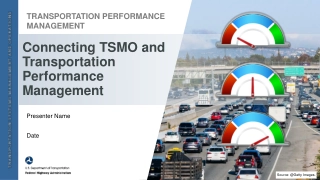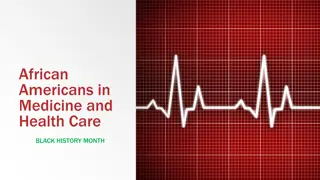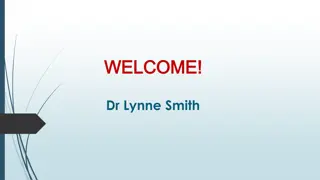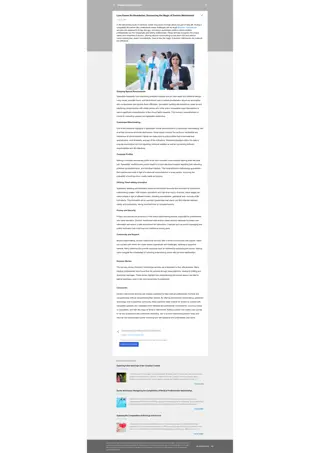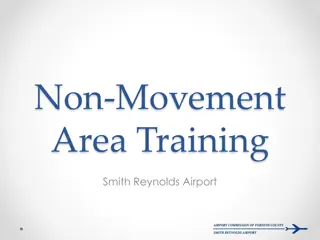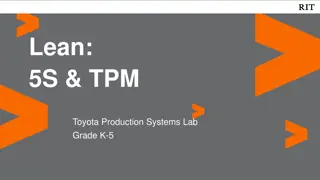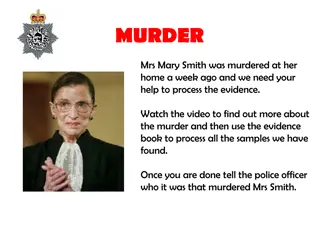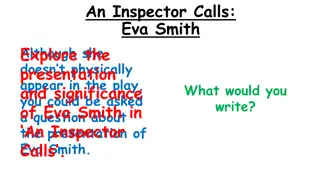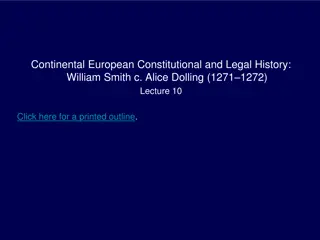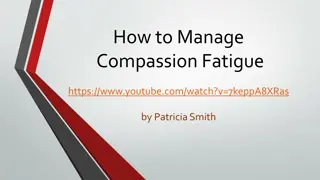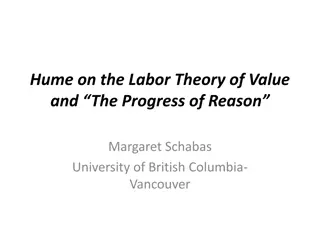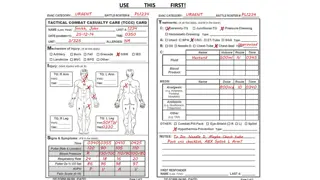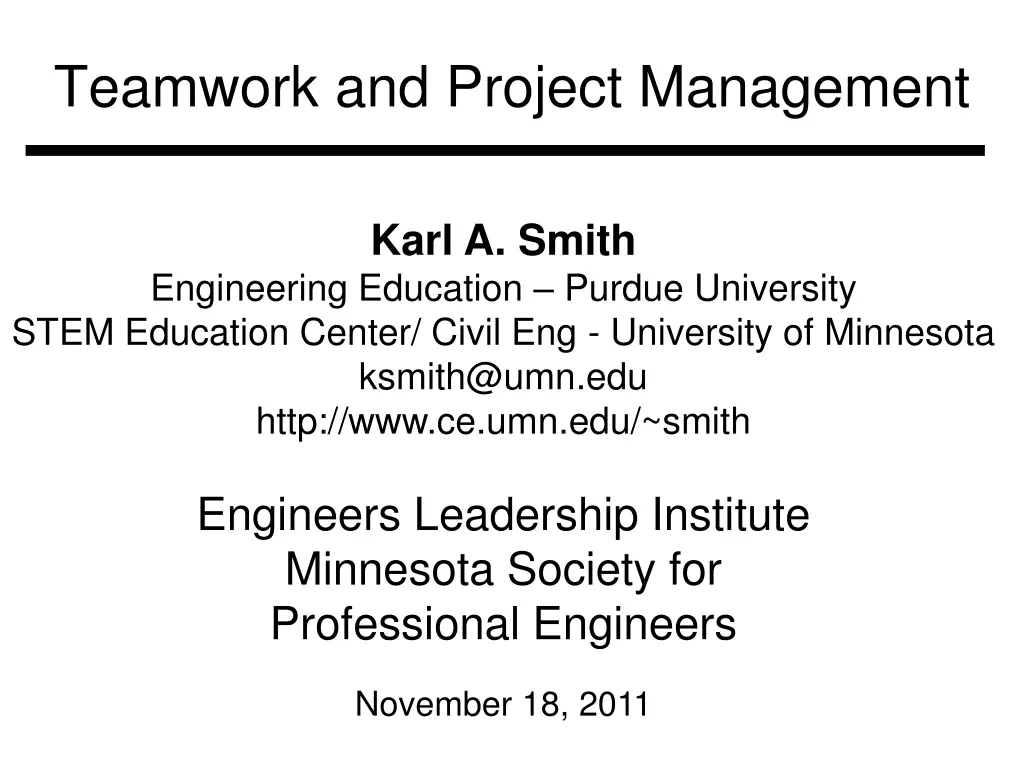
Understanding Teamwork and Project Management
Explore the principles and practices of teamwork and project management, including project definition, key components of success, challenges faced, and the Project Management Body of Knowledge (PMBOK).
Download Presentation

Please find below an Image/Link to download the presentation.
The content on the website is provided AS IS for your information and personal use only. It may not be sold, licensed, or shared on other websites without obtaining consent from the author. If you encounter any issues during the download, it is possible that the publisher has removed the file from their server.
You are allowed to download the files provided on this website for personal or commercial use, subject to the condition that they are used lawfully. All files are the property of their respective owners.
The content on the website is provided AS IS for your information and personal use only. It may not be sold, licensed, or shared on other websites without obtaining consent from the author.
E N D
Presentation Transcript
Teamwork and Project Management Karl A. Smith Engineering Education Purdue University STEM Education Center/ Civil Eng - University of Minnesota ksmith@umn.edu http://www.ce.umn.edu/~smith Engineers Leadership Institute Minnesota Society for Professional Engineers November 18, 2011
Teambuilding and Project Management Perspectives Capitalizing on individual differences Leading a team to consensus; the importance of buy-in Expanding a team s capabilities Perspectives on the role of project manager Key components to project and/or team success Project coordination 2
What do you already know about Teamwork and Project Management? [Background Knowledge Survey] What is your experience in teamwork and project management? 1-3: limited experience (1) to very experienced (3) What is your level of familiarity with project management tools and strategies? 1-3: low (1) to high (3) What do you feel are important considerations about teamwork and project management? What are challenges you have faced with teamwork and project management?
What is a Project? A project is a combination of human and nonhuman sources pulled together in a temporary organization to achieve a specified purpose. Cleland and Kerzner, 1985 A project is a temporary endeavor undertaken to create a unique product, service, or result. Project Management Body of Knowledge (PMBOK), 2004 A project is a sequence of unique, complex, and connected activities that have one goal or purpose and that must be completed by a specific time, within budget, and according to specification. Wysocki, 2011. 4
The Project Management Body of Knowledge is the sum of knowledge within the profession of project management PMBOK www.pmi.org 7
Project Management Agile/Adaptive 9
Types of Projects On-going operations Traditional Project Management PMBOK Innovation Adaptive Project Framework Wysocki 10
Types of Projects Exploitation vs Exploration (March, 1991) Exploiting Old Ways: Organizing for Routine Work Drive out variance Exploring New Ways: Organizing for Innovative Work Enhance variance See old things in new ways Replicate the past See old things in new ways Break from the past Goal: Make money now Goal: Make money later March, J.G. 1991. Exploration and exploitation in organizational learning. Organizational Science, 2, 71-87
Explore - Exploit James March (1991) Exploration and exploitation in organizational learning Roger Martin (2010) Design of Business Characteristics of exploration and exploitation, Table 1-1, p. 20 Govindarajan and Trimble (2010) The Other Side of Innovation, Key differences between typical planning processes for the Performance Engine and best practices for innovation, Table 4.1, p. 99 Scott Page (2010) Understanding Complexity Lecture 5 Explore Exploit: The Fundamental Trade- Off
Percentage of Current Work that is Project Work N 7 6 5 4 N 3 2 1 0 0-25 26-50 51-75 76-100 13
Number of Projects Currently Working On Response 1.2 1 0.8 0.6 Response 0.4 0.2 0 0-5 6-10 11-15 16-20 20+ 14
Distribution Between Supporting Innovation and Supporting On- Going Operations Response 1.2 1 0.8 0.6 Response 0.4 0.2 0 25-75 50-50 75-25 15
Percentage of Current Work that is Project Work N 7 6 5 4 N 3 2 1 0 0-25 26-50 51-75 76-100 16
Number of Projects Currently Working On Response 9 8 7 6 5 Response 4 3 2 1 0 0-5 6-10 11-15 16-20 20+ 17
Distribution Between Supporting Innovation and Supporting On- Going Operations Response 9 8 7 6 5 Response 4 3 2 1 0 25-75 50-50 75-25 18
Developing Project Management Expertise What is expertise? What is project management expertise? Why is this important? How to develop expertise? 19
Expertise Implies: a set of cognitive and metacognitive skills an organized body of knowledge that is deep and contextualized an ability to notice patterns of information in a new situation flexibility in retrieving and applying that knowledge to a new problem 20 Bransford, Brown & Cocking. 1999. How people learn. National Academy Press.
Expert Project Managers 1. Take a moment to recall one of your expert project managers 2. Describe him or her briefly 3. Listen as others describe their expert project managers 4. List common characteristics 21
What is takes to be a good project manager --Barry Posner (1987) Leadership Skills (68%) Sets Example Energetic Vision (big picture) Delegates Positive Coping Skills (59%) Flexibility Creativity Patience Persistence Technological Skills (46%) Experience Project Knowledge Communications (84% of the respondents listed it) Listening Persuading Organizational skills (75%) Planning Goal-setting Analyzing Team Building Skills (72%) Empathy Motivation Esprit de Corps
Acquisition of Expertise Fitts P, & Posner MI. Human Performance. Belmont, CA: Brooks/Cole, 1967. Cognition: Learn from instruction or observation what knowledge and actions are appropriate Associative: Practice (with feedback) allowing smooth and accurate performance Automaticity: Compilation or performance and associative sequences so that they can be done without large amounts of cognitive resources The secret of expertise is that there is no secret. It takes at least 10 years of concentrated effort to develop expertise. Herbert Simon
Paradox of Expertise The very knowledge we wish to teach others (as well as the knowledge we wish to represent in computer programs) often turns out to be the knowledge we are least able to talk about. 25
Teamwork and Project Management Exercise Project Life Cycle The engineering method is design under constraints Wm. Wulf, President, National Academy of Engineering The engineering method is the use of heuristics to cause the best change in a poorly understood situation within the available resources Billy Koen, Mechanical Engineering Professor, UT-Austin, author Discussion of the Method 26
Design-Build Project Teams of 3-4 randomly assigned Experience entire project life cycle in about 30 minutes Goal is for all teams to meet the specification (design requirement) Attend to both the task and the team work 27
Team Member Roles Task Recorder Process Recorder Time Monitor Materials Manager 28
Design objective Design and build a tower at least 25 cm high that can support a stack of textbooks. The tower is built from index cards and office tape. Design rules Materials are 100 index cards and one roll of office tape Cards can be folded but not torn No piece of tape can be longer than 2 inches Tower cannot be taped to the floor Tower must be in one piece, and easily transported in one hand Time to design and build: 15 minutes Height is measured from the ground to the lowest corner of the book placed on top Tower must support book for at least 10 seconds before the measurement is made Room must be cleaned up before measurements are made.
Group Processing Plus/Delta Format Delta ( ) Plus (+) Things That Group Did Well Things Group Could Improve
Teamwork & Project Management Heuristics-- Examples Identify the weak link and Allocate resources to the weak link Freeze the design--at some stage in the project (when about 75% of the time or resources are used up) the design must be frozen Discuss the process and ask meta-level questions, e.g., What are we doing? Why are we doing it? How does it help? 31
What is a project? (Cleland and Kerzner, 1985; Nicholas, 1990) a combination of human and nonhuman sources pulled together in a temporary organization to achieve a specified purpose. Features Definable purpose with established goals Cost, time and performance requirements Multiple resources across organizational lines One-time activity Element of risk Temporary activity Process with phases/ project life cycle 36
Performance, Cost, and Time Project Targets 37
Successful Projects 1. Take a moment to recall one of your most successful projects 2. Describe it briefly 3. Listen as others describe their successful projects 4. List common characteristics 40
Characteristics ? 41
A recent survey of technology projects in the United States by the Project Management Institute reveals some startling percentages. Close to half of the projects started were never finished, 30% were completed but took at least twice as long as expected, some took 5 times as long. Only 10% of the projects were finished on time.
Standish Group Survey of Software Project 1994 (Lewis, 2000, p. 109) 17% Succeeded 50% Revised 33% Failed
Critical Success Factors and Their Importance for System Implementation (Listed in decreasing order of correlation) [Pinto (1986), See Smith (2004), p. 67] 1.Project mission. Initial clearly defined goals and general directions. 2.Top management support. Willingness of top management to provide the necessary resources and authority/power for implementation success. 3.Schedule plans. A detailed specification of the individual action steps for system implementation. 4.Client consultation. Communication, consultation, and active listening to all parties impacted by the proposed project. 5.Personnel. Recruitment, selection, and training of the necessary personnel for the implantation project team. 6.Technical tasks. Availability of the required technology and expertise to accomplish the specific technical action steps to bring the project on-line. 7.Client acceptance. The act of "selling" final product to its ultimate intended users. 8.Monitoring and feedback. Timely provision of comprehensive control information at each stage in the implementation process. 9.Communication. The provision of an appropriate network and necessary data to all key actors in the project implementation process. 10.Troubleshooting. Ability to handle unexpected crises and deviations from plan.
Top Ten Reasons Why Projects Succeed (Standish Group, 2000) Executive management support User involvement Experienced project manager Clear business objectives Minimized scope Standardized infrastructure Firm basic requirements Formal methodology Reliable estimates Skilled staff Wysocki & Rudd, p. 34 45
Predictors of Lowered Project Success William M. Hayden Unrealistic project work plans Inability to deal early with suspected problem issues Technical complexities not well communicated to team members Conflict between client expectations and the state of deliverables Insufficient involvement on the part of senior management early in the life cycle
Session Summary (Minute Paper) Reflect on the session: 1. Most interesting, valuable, useful thing you learned. 2. Things that helped you learn. 3. Comments, suggestions, etc 4. Pace: Too slow 1 . . . . 5 Too fast 5. Relevance: Little 1 . . . 5 Lots 6. Instructional Format: Ugh 1 . . . 5 Ah 47 47
ISE 5101 Fall 2011 Session 1 12 10 1 8 2 3 6 4 4 5 2 0 Q4 Q5 Q6 Q4 Pace: Too slow 1 . . . . 5 Too fast (3.3) Q5 Relevance: Little 1 . . . 5 Lots (4.3) Q6 Format: Ugh 1 . . . 5 Ah (4.7) 48

